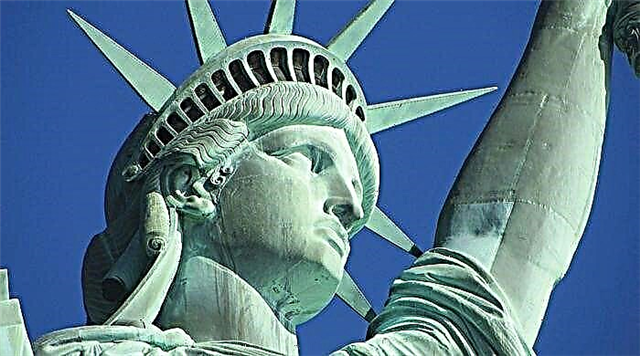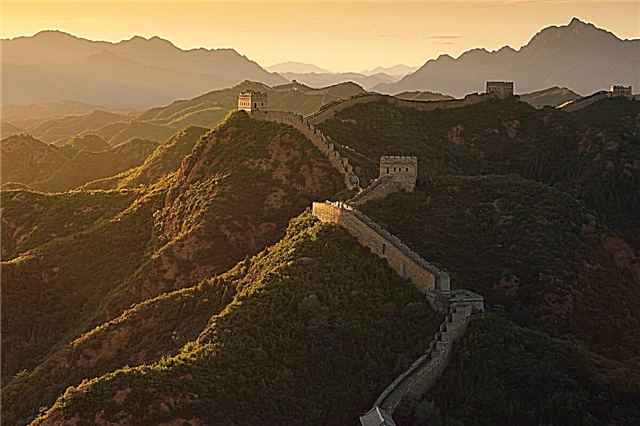The Great Wall of China is one of the most famous structures in the world. The architectural monument is of interest to tourists, builders and scientists due to the scale and riddles that it has generated over the centuries of its existence. What is the Great Wall of China, interesting facts about it, legends and much more in this article.
Duration of construction
In general, the Great Wall of China is a collection of many walls built at different times.

The building began to be laid in the 3rd century. BC. during the Warring States Period (475-221 biennium BC.). At that time, Emperor Qin Shi Huang ruled and the Celestial Empire needed protection from the raids of the Xiongnu nomads. But the idea of building a wall appeared even earlier - during the Spring and Autumn period (771-476 BC.).
Construction covers a period of one and a half thousand years. For its complete erection, it took the efforts of 10 dynasties, starting from the III century. BC. until the 17th century. AD The construction of the wall was interrupted during the Tang, Sun and Yuan dynasties. During the Ming dynasty (1368-1644) construction resumed, and almost all sections of the wall that can be observed now were erected just then.
Who built the Great Wall of China
Almost a million people had to work on the construction of the structure, that is, one fifth of the population of the state. It was difficult to build it: there were no roads, necessary for the construction of infrastructure, water and food were not enough for everyone involved in the construction.

Slaves, peasants and soldiers were involved in the construction. Grueling work and epidemics have killed at least hundreds of thousands of people. In addition, the terrain of the construction turned out to be difficult for the construction of such a huge structure on it - the wall had to pass through the mountain range, go around all the spurs, accompanied by high ascents and decent-sized gorges. As a result of this placement, she organically blended into the landscape.
Additional Information!The fall of the Qin dynasty was to some extent caused by outbreaks of popular unrest due to full mobilization, the attraction of all kinds of forces and resources of the state for the construction of the structure.
Why are the loopholes directed towards China
Sometimes you can stumble upon news that the structure was actually not built by the Chinese due to the location of the loopholes in the direction of China. But these statements and versions are groundless and do not have any arguments.
In fact, the loopholes of the wall are turned in two directions. And there is an explanation for this. Nomads could overcome its defenses and enter Chinese territory. It was almost impossible to overtake them then. When they were heading back, with the loot (horses, money or other items of value to them - ceramics, bags of rice), they faced a heavy ferry across the obstacle. Here the fighters used loopholes directed inland.
You May Also Like

Note!Due to the long length of the wall, it was not possible to defend it at the same time in all areas due to the lack of such a number of people, so it was not worth a lot of work for the nomads to break through it.
In addition, there are historically proven information and descriptions in the form of plans, estimates and reports on the construction of the fortification, which leaves no doubt about the construction of it by the Chinese.
Inventions during construction
During the construction of the Great Wall of China, local inventors invented a wheelbarrow, using it throughout construction. The wheelbarrow was a flooring made of wood with handles, placed on one wheel.
China was not provided with river traffic and pack animals, so the wheelbarrow was used not only in transportation during construction, but also in supplying the army.
The Chinese sought to keep the advanced technology for those times from the enemy. The Chinese cars were equipped with a larger wheel located in the center. Therefore, she won in maneuverability and convenience from the Europeans.
It is interesting! Sometimes sails were attached to the wheelbarrows, which made it possible to accelerate its speed to 60 km / h.

For defense, the Chinese used advanced weapons - axes, crossbows, hammers, spears, halberds and another invention they created - gunpowder. In more dangerous areas, ditches and ditches were used. Watchtowers were built along the wall, from which they monitored the territory, were used to send signals, were used to deploy troops and store supplies.
Legends associated with the Great Wall of China
The existence of such a great structure has given rise to a number of legends and hoaxes. Most of them are associated with the death of a large number of people.
Wall of tears
During the construction of the first section of the wall, Emperor Qin Shi Huang was curious how much more construction would take, since it stretched out for many years. The length of this section should have been 10000 li - translated from Chinese "yi wan". The emperor received a prediction that the construction would end when a man named Wang was buried under the structure.
You May Also Like
The ruler issued a corresponding decree, a completely innocent man was caught and buried under the wall. It is clear that this did not affect the construction time in any way - it did not end.
But from that moment on, all the dead during the construction of the wall were buried under it in an upright position, like eternal guards. Therefore, the wall was formerly called the wall of tears or the longest cemetery in the world. According to legend, putting your ear to the wall, you can hear the groans and cries of the dead during the construction.
Important!Specialists from the Society for the Study of the Great Wall of China, while dismantling the fragments of the wall, did not find human remains. But many of them were found along the wall.
The Dragon
According to one of the legends, a huge dragon showed people the direction and place of construction of the wall. Walking along the borders, he left traces along which the structure was erected. According to some statements, the very shape of the wall resembles a soaring dragon.
Meng Jiang
This story is described as one of the four great tales of China. The legend has several variations, but the last one established during the Qing dynasty is considered relevant.

Ms. Meng Jiang's husband was forced into service by imperial officials and sent to the construction site of the wall. Without hearing from him, the woman brought him winter clothes. But, unfortunately, upon reaching the construction site, she learned that her husband had died. Full of grief, she began to cry so that part of the wall collapsed from crying, revealing his bones.
Additional Information!The section of the wall touched upon in legend is now called the Great Qi Wall in what is now Shandong Province. In memory of this history, a monument and temples were erected.
JiaYuguan Architect
Taking a tour of the section of the Great Wall of China called JiaYuguan, which is located in the Gobi Desert and is quite well preserved, the guides will point to one of the bricks in the wall.
The architect JiaYuguan designed this part of it and, when calculating, was able to determine how many bricks are needed to build it. Upon completion of the work, only one brick remained. It was built into the wall and symbolizes the memory of the gifted architect.
Widow Tower
The so-called Widow Tower is located in Jixian County near a section of the Dongshan Wall. Its height is approximately 13 m, there are dragons on the corners of the roof, and statues of a unicorn, a phoenix and a lion on the cornices.

According to legend, the tower was built by the young wives of 12 soldiers from Henan province who died during the construction of this section of the wall.With this, they wanted to complete the important for the state work of their husbands, inspired by the speeches of the general, who directed the construction and urged the women to complete the work.
Metal soup
The Huanghuacheng section of the wall is named after the yellow flowers that bloom here in summer. It is located on the outskirts of Beijing and was built during the reign of the Ming dynasty.
The construction was supervised by General Tsai Kai, who spent too much time and money on the construction of a section of the wall. The authorities were against this, and the general was executed. After some time, the emperor noticed a feature that distinguished this part of the wall from others - it was extremely strong and distinguished by its steepness, which was dangerous for enemies.
It turned out that the bricks were held together by sticky rice soup. Regretting his decision and realizing what contribution Tsai Kai had made, he ordered to build a tomb and erect a memorial stone in honor of the general. On the stone, by his order, "Jintang", which translates as "metal soup", was engraved. This comparison underlines the exceptional strength of this part of the wall.
For reference! During World War II, Japanese troops managed to blow up this section of the wall. Part of it collapsed into the lake and now on both sides of the reservoir are the remains of the structure. After that, it was believed that the spirit of General Tsai Kai helped drive out the enemy who was trying to overcome the wall.
Emperor Zhou Youwang
The Zhou emperor had a habit of entertaining himself in an unusual way. He gave the order to light the signal lights on the towers of the wall at a time when there was no threat.
One day, when the danger came and the enemy was actually advancing, the fires were lit, but no one paid attention to it properly. The enemies reached the city and the emperor was killed.
Space antenna
This legend dates back to a later time. Researchers have identified the possibility of the structure functioning as a power supply battery of enormous size and capacity.
The structure is so large that, thanks to its electrical capacity, it can make the geomagnetic field vibrate as the Earth rotates around its axis, spreading a signal into intergalactic depths.

Important! Scientists have revealed a paradox - if in ancient times people were more technically savvy, then why was the construction of the structure so long? After all, they could use a technique that accelerated construction at times.
Interesting Facts
During the existence of the grandiose structure, a lot of interesting facts and events that happened to it have accumulated. Here are some of them:
- Wall distance can be measured in almost9000 km, in the widest section its value is 9.14 m, the tower is considered the highest 7.92 m.
- For a long time, the defensive structure remained unknown to the rest of the world; the Portuguese Bento de Gois is considered the first European to reach it. in 1605.
- The building material was crushed stone, stones, wood and lime, contrary to the well-known myth about the content of human bones in building materials.
- A significant part of the structure is in disrepair,70s people were advised to use its bricks for building houses, since the structure was considered a symbol of despotism.
- Contrary to the well-known myth, the wall is not visible from space either due to its insufficient width and not contrasting color in relation to the environment. From near-earth orbit, it is barely visible under the right conditions. Satellites in low orbit can capture it using radar.
- The purpose of the fortifications was not only in defense against the enemy, but also in the implementation of border control, regulation of trade and immigration, the introduction of duties.
- UNESCO entered into1987 year landmark in the list of great national and historical sites of the world.
- Night excursions are organized to the sights, it is illuminated with lights, which gives it a special look.
- Maintenance and care of the structure is quite laborious. This is now being done by two organizations, the China Great Wall Society and the International Friends of the Great Wall.
- Many battles were fought here, the last of which was in 1938 during the Sino-Japanese War.
- A small section of the structure borders on the southern part of the Chita region.
In winter, there are fewer tourists than in the warm season. But the winds are much colder, this should be taken into account when traveling with a child. You can get to the wall from Beijing by tourist or regular bus, train, as part of a group.
The sight has always been covered with a veil of secrets and mysteries, and the size of the wall still amazes the imagination. The Great Wall of China was rightfully included in the list of "New Wonders of the World" and now it is a World Heritage Site, because with all its appearance the wall shows what remarkable strength and perseverance the Chinese people were able to overcome on the way to its erection.











